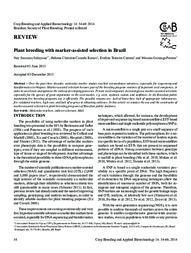Plant breeding with marker-assisted selection in Brazil.
Plant breeding with marker-assisted selection in Brazil.
Author(s): SAKIYAMA, N. S.; RAMOS, H. C. C.; CAIXETA, E. T.; PEREIRA, M. G.
Summary: Over the past three decades, molecular marker studies reachedextraordinary advances, especially for sequencing and bioinformatics techniques.Marker-assisted selectionbecamepart of the breeding program routines of important seed companies, in order to accelerate and optimize the cultivar developing processes. Private seed companies increasingly use marker-assisted selection, especially for the species of great importance to the seed market, e.g. corn, soybean, cotton, and sunflower. In the Brazilian public institutions few breeding programs use it efficiently.The possible reasons are: lack of know-how, lack of appropriate laboratories, few validated markers, high cost, and lack of urgency in obtaining cultivars. In this article we analyze the use and the constraints of marker-assisted selection in plant breeding programs of Brazilian public institutes
Publication year: 2014
Types of publication: Journal article
Unit: Embrapa Coffee
Keywords: Indirect selection, MAS, Molecular marker
Observation
Some of Embrapa's publications are published as ePub files. To read them, use or download one of the following free software options to your computer or mobile device. Android: Google Play Books; IOS: iBooks; Windows and Linux: Calibre.
Access other publications
Access the Agricultural Research Database (BDPA) to consult Embrapa's full library collection and records.
Visit Embrapa Bookstore to purchase books and other publications sold by Embrapa.

